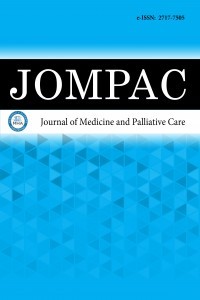1.
American Diabetes Association. Diagnosis and classification ofdiabetes mellitus. Diabetes Care. 2011;37 (Suppl_1):62-S69.
2.
Priya G, Kalra S, Dasgupta A, Grewal E, Diabetes insipidus: a pragmaticapproach to management. Cureus. 2021;13(1):e12498- e12498.
3.
Prabhakar PK, Pathophysiology of secondary complications ofdiabetes mellitus. Pathophysiology. 2016;9(1):32-36.
4.
Sun H, Saeedi P, Karuranga S, et al. IDF Diabetes Atlas: Global,regional and country-level diabetes prevalence estimatesfor 2021 and projections for 2045. Diabetes Res Clin Pract.2022;183:109119.
5.
Sönmez A, Ozdoğan O, Arıcı M, et al. Diyabette kardiyovaskülerve renal komplikasyonların önlenmesi, tanısı ve tedavisi içinEndokrinoloji Kardiyoloji Nefroloji (ENKARNE) Uzlaşı Raporu.Turk J Endocrinol Metab. 2021;25(4):392-411.
6.
Rajpurkar P, Chen E, Banerjee O, Topol EJ. AI in health andmedicine. Nat Med. 2022;28(1):31-38.
7.
Ghaffar Nia N, Kaplanoglu E, Nasab A. Evaluation of artificialintelligence techniques in disease diagnosis and prediction.Discover Artificial Intelligence. 2023;3(1):5. doi:10.1007/s44163-023-00049-5
8.
Ali YA, Awwad EM, Al-Razgan M, Maarouf A, Hyperparametersearch for machine learning algorithms for optimizing thecomputational complexity. Processes. 2023;11(2):349.
9.
Birjais R, Mourya AK, Chauhan R, Kaur H, Prediction anddiagnosis of future diabetes risk: A machine learning approach.SN Appl Sci. 2019;9(1):1-8.
10.
Tigga, NP, Garg S. Prediction of type 2 diabetes using machinelearning classification methods. Procedia Comput Sci. 2020;167:706-716.
11.
Singh, N, Singh P. Stacking-based multi-objective evolutionaryensemble framework for prediction of diabetes mellitus.Biocybern Biomed Eng. 2020;40(1):1-22.
12.
Lyngdoh AC, Choudhury NA, Moulik S. Diabetes diseaseprediction using machine learning algorithms. 2020 IEEE-EMBSConference on Biomedical Engineering and Sciences (IECBES),Langkawi Island, Malaysia. 2021:517-521.
13.
Kumari S, Kumar D, Mittal M, An ensemble approach forclassification and prediction of diabetes mellitus using soft votingclassifier. Int J Cog Comp in Eng. 2021;2:40-46
14.
Chang V, Ganatra MA, Hall K, Golightly L, Xu QA. An assessmentof machine learning models and algorithms for early predictionand diagnosis of diabetes using health indicators. HealthcareAnalytics. 2022;2(1):100118.
15.
Yakut Ö. Diabetes prediction using colab notebook-basedmachine learning methods. IJCESEN. 2023;9(1):36-41.
16.
Kluyver T, Ragan-Kelley B, Pérez F, et al. Jupyter Notebooks—Apublishing format for reproducible computational workflows. InPositioning and Power in Academic, Players, Agents and Agendas;IOS Press: Amsterdam, The Netherlands. 2016;pp. 87-90.
17.
The Python Library Reference, Release 3.8.8, Python SoftwareFoundation. Available online: https://www.python.org/downloads/release/python-388/ (accessed on 10 May 2023).
18.
Kumar VH. Python libraries, development frameworksand algorithms for machine learning applications. IJERT.2018;7(4):2278-0181.
19.
Pima Indians Diabetes Database | Kaggle, https://www.kaggle.com/datasets/uciml/pima-indiansdiabetes-database/ Accessed 09May. 2023.
20.
Joshi, AP, Patel BV, Data preprocessing: The techniques forpreparing clean and quality data for data analytics process.Orient. J Comput Sci Technol. 2021;13(0203):78-81.
21.
Ahsan MM, Mahmud MP, Saha PK, Gupta KD, Siddique Z. Effectof data scaling methods on machine learning algorithms andmodel performance. Technologies. 2021;9(3):52.
22.
Venkatesh B, Anuradha J, A review of feature selection and itsmethods. Cybern Inform Tech (CIT). 2019;19(1):3-26.
23.
Jamaluddin NSA, Kadir SA, Abdullah A, Alias SN, Learningstrategy and higher order thinking skills of students in accountingstudies:Correlation and regression analysis. Univers J Educ.2020;8(3C):85-90.
24.
Prusty S, Patnaik S, Dash SK. SKCV: Stratified K-fold cross-validation on ML classifiers for predicting cervical cancer. FrontNanosci. 2022;4:972421.
25.
Ibrahim I, Abdulazeez A, The role of machine learning algorithmsfor diagnosing diseases. J App Sci Techol Trends. 2021;2(01):10-19.
26.
Belete DM, Huchaiah MD, Grid search in hyperparameteroptimization of machine learning models for prediction of HIV/AIDS test results. Int J Comput Appl. 2022;44(9):875-886.
27.
Nohara Y, Matsumoto K, Soejima H, Nakashima N, Explanationof machine learning models using shapley additive explanationand application for real data in hospital. Comput MethodsPrograms Biomed. 2022;214:106584.
28.
Pedregosa F, Varoquaux G, Gramfort A, et al. Scikit-learn: machinelearning in Python. J Mach Learn Res. 2011;12:2825-2830.

